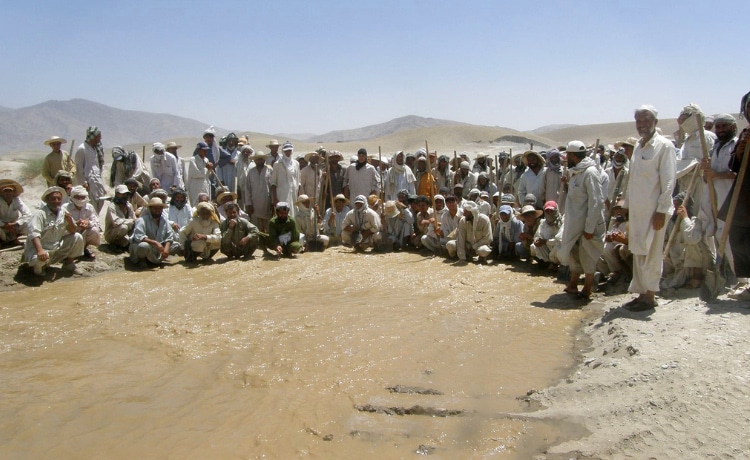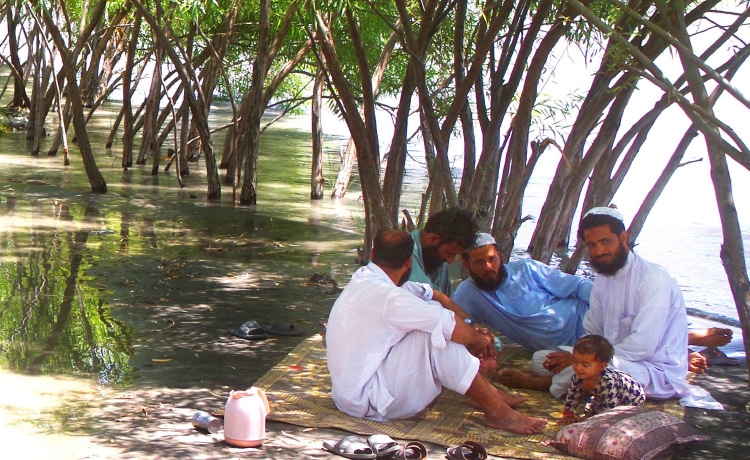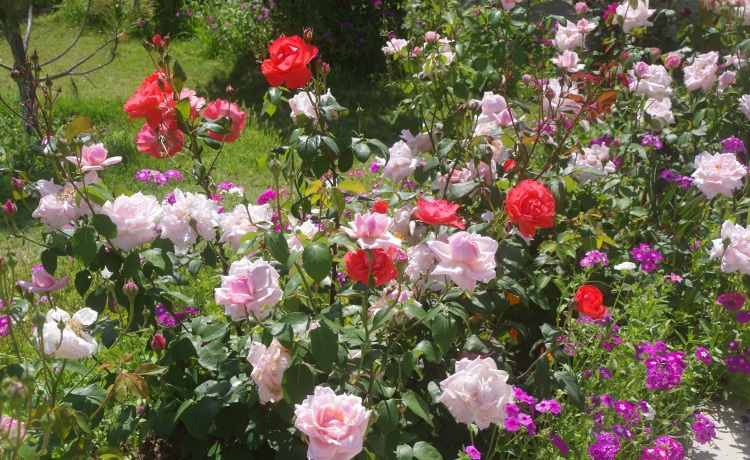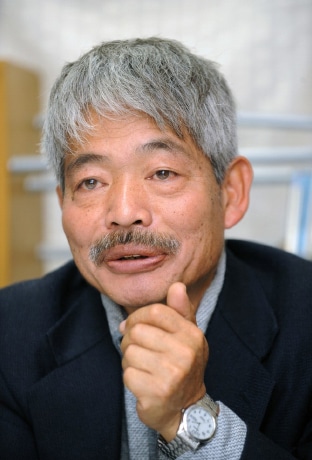【In the Land of the Afghans – Reports from Dr. Tetsu Nakamura】A love for flowers and poetry
Published on September 2, 2019 – The Nishinippon Newspaper
In the Gamberi Desert of eastern Afghanistan, a peaceful silence reigns. What was long a desolate wilderness, a water-less hell, has been replaced by a deep forest and the sounds of human settlement in the distance. The sound of children playing, cows mooing and shepherds’ voices, all coming together in harmony with the twitter of birds and the wind passing through the trees.
We have a large farm in this area and cultivation is ongoing. In the center of this land, a 40,000㎡ memorial park, where seasonal flowers bloom, provides people with a place to relax.
“This was an uninhabited desert.” Reflecting on past miseries in this area, the peaceful spectacle that this park represents is like a dream.
■A life or death struggle for local farmers
In the summer of 2009, the construction of the irrigation canal which began in 2003 confronted its final hurdle in Gamberi Desert. Seven years have passed since the start of the construction of the canal. Nearly 400 laborers toiled in extreme conditions under the baking sun, covered in mud. The temperature in the desert exceeded 50 degrees Celsius by late morning. The leaves of the few trees in the area resembled dry flowers due to dehydration. Many laborers suffered from heatstroke yet none attempted to rest.
All of the laborers were locals who had become refugees after losing their farmland due to drought. The intense drought of 2000 wrought havoc in many villages, causing countless deaths from starvation and forcing villagers to abandon their homes. Many farmers barely had food enough to feed themselves for even a single day. The rumor that water was going to come to the area inspired hope, and many of the displaced population returned home.
They had only two wishes; to be able to eat three times a day and to live together with their families at home. If the irrigation canal could be completed, these wishes would be granted. If not, they would be forced to return to a life in exile, with no guarantee that they would have enough food to sustain themselves. The success or failure of the irrigation canal was a matter of life and death.
In August 2009, after carrying out a successful trial to test the water flow capacity in the irrigation canal, the farmers-turned-laborers were overjoyed. They would no longer have to beg for their daily meal. Their fear of dying from starvation had passed, and they could live in good conscience with dignity before God. They savored the joy of this new-found freedom. The instinctive desire to live of those who face an uphill battle to survive was one of the primary reasons that the irrigation canal project was a success. “Now we can live!” I still believe that this joyous cry which transcends social status and which can only be gained by living life to the fullest demonstrates the true radiance of humanity.
Soon afterward, their prayers were answered. The arid desert was gradually replaced by green fertile land and, with the addition of eight new intake weirs and irrigation canals, the area of irrigated, arable land was dramatically increased. As of 2019, a total of 16,500 hectares with 650,000 inhabitants has been restored to farming. The Gamberi Memorial Park was opened to commemorate this struggle.
■A refined culture
Afghans love flowers and poetry. People from all corners of the country come to visit the beautiful flower garden within the memorial park. Rose, jasmine, pomegranate and many other such flowers were not selected and planted by specialists, but by our Peace Japan Medical Services (PMS) staff and the laborers, each having brought some plants. Surrounding the park is an orchard with 30,000 orange trees. In early spring, the whole area is perfumed by white orange-blossoms.
In Afghanistan, traditional poetry recitations remain commonplace, with poets gathering to recite improvised verses on the theme of seasonal flowers. In the south, pomegranates from Kandahar, and in the east, oranges from Jalalabad are famous. Since ancient times, poets could be found amongst all walks of life, from farmers to the nobility. Regardless of social status and nationality, they would gather. Poetry here is an entirely oral tradition; there are famous poets who cannot read and write. Even among the unschooled laborers themselves, if two or more people came together, it would not be unusual to see them enjoying improvised poetry recitals.
The devastating drought in 2000 almost entirely wiped out the citrus fruit trees in eastern Afghanistan, and the annual tradition of orange-related poetry recitations was headed towards the same fate. But those who experience the perfumed air of the orange grove at Gamberi Memorial Park dream of the day when this tradition of recitals is fully revived. PMS’s Green Ground Project is not only actively restoring agricultural livelihoods, but also supporting traditional culture.
When we emphasize the importance of education, we tend to forget the rich culture deeply rooted in the region. Material poverty does not necessarily mean spiritual poverty, just as well as literacy and enrollment rates do not necessarily provide adequate measures of culture. I cannot help but believe that confidence and pride were firmly embedded in this cry of relief, “Now we can live!”
× ×
This is a translation of a report from Afghanistan by Dr. Tetsu Nakamura, a Japanese medical doctor who was gunned down on December 4, 2019 in Afghanistan at the age of 73. Dr. Nakamura was the head of the international NGO, Peace Japan Medical Services (PMS). In addition to medical services, PMS provides various forms of assistance to local communities in Afghanistan’s eastern Nangarhar province, including the construction of irrigation systems, related agricultural programming and provision of food support. PMS is funded by Peshawar-kai, which was established in 1983 to collect donations from people and support the project implementation of Dr. Nakamura and his team.
This report is one of 27 installments in the series “In the Land of the Afghans – Reports from Dr. Tetsu Nakamura,” which ran from May 25, 2009 to December 2, 2019. They were originally published by the local newspaper in Dr. Nakamura’s hometown in Fukuoka, Japan. The text has been translated from Japanese to English, with the support of Peshawar-kai, by more than 30 volunteers, many of whom work in the field of humanitarian and development aid, and who have been and will continue to be inspired by Dr. Nakamura's work and philosophy.






